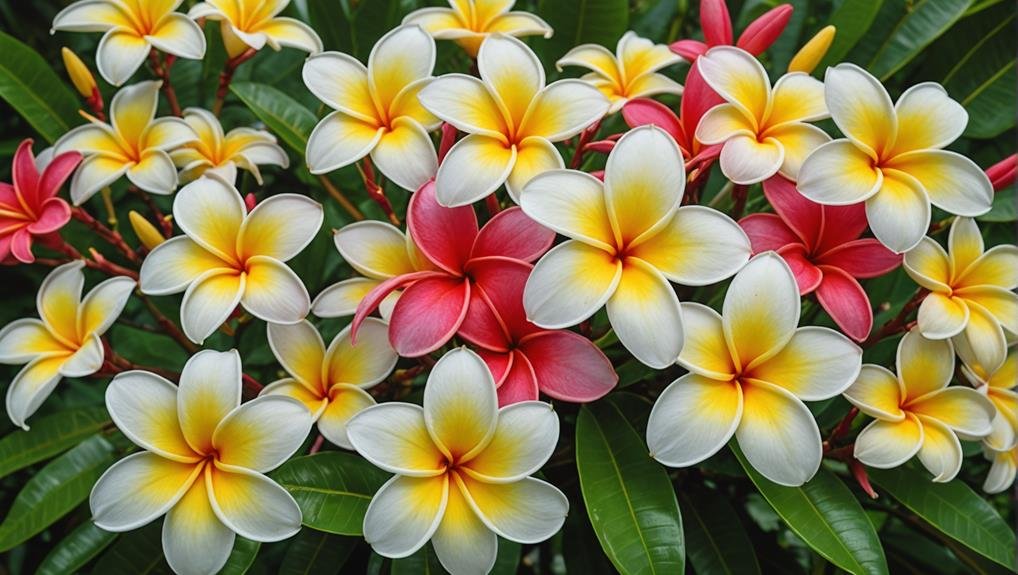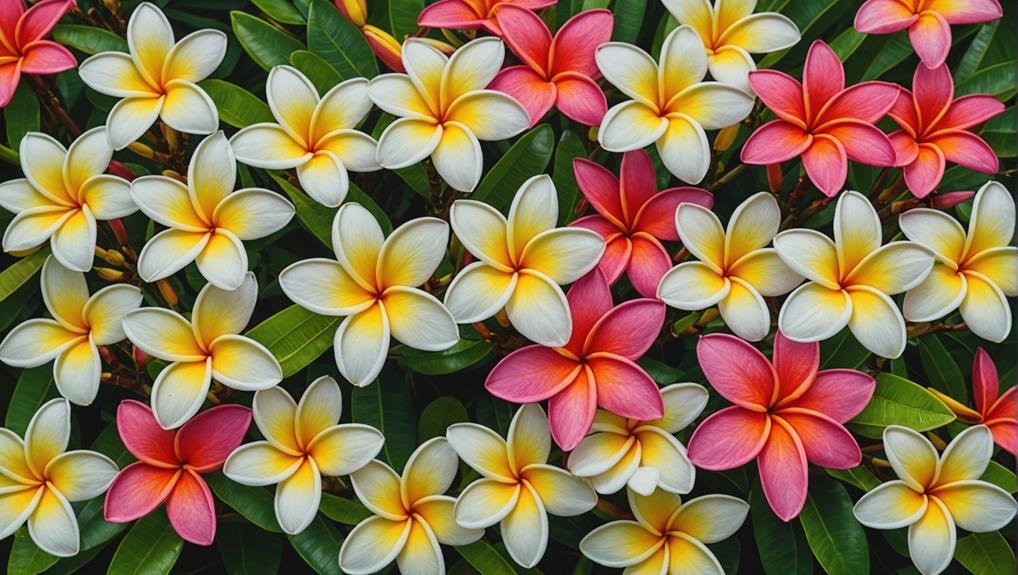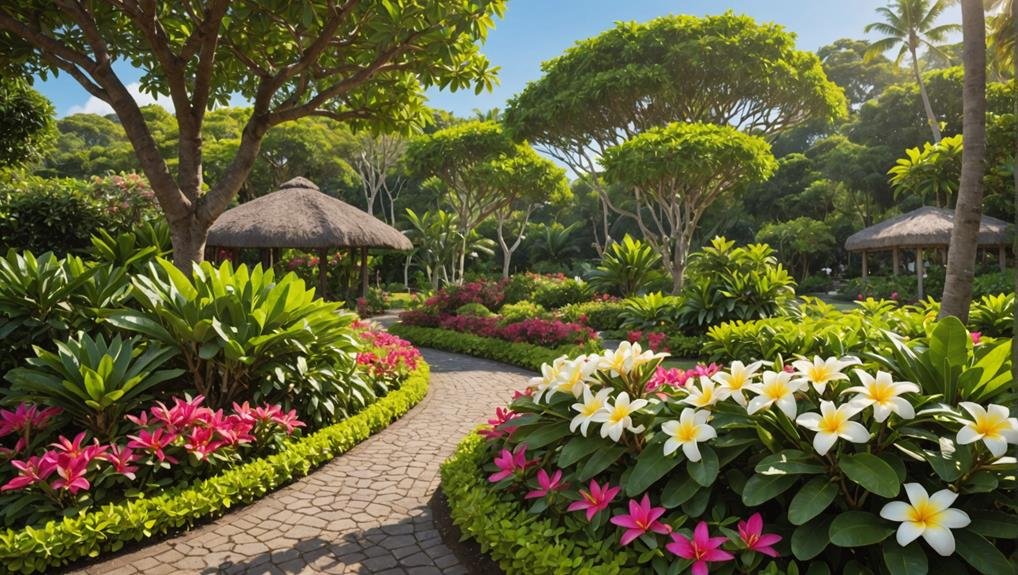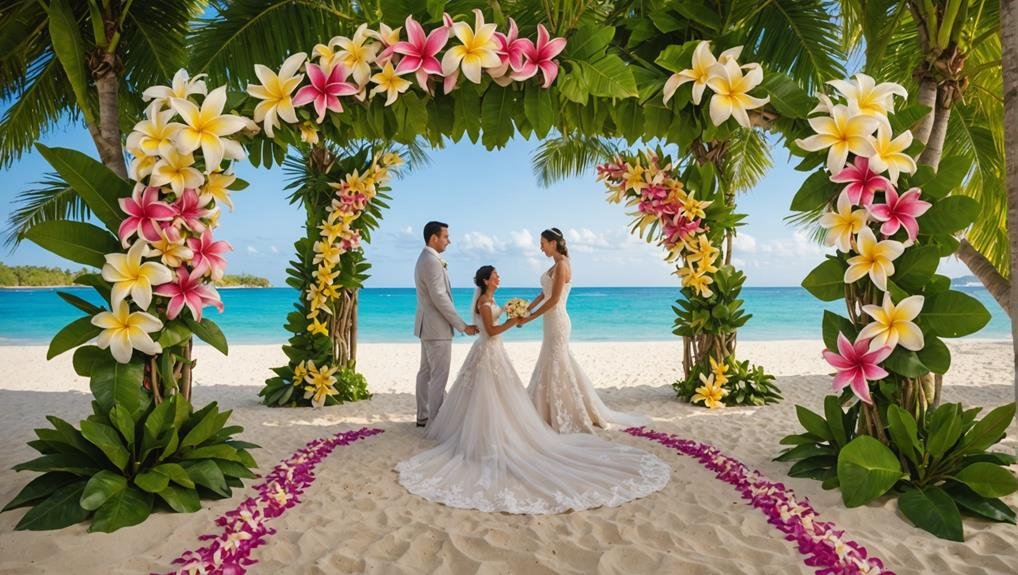When envisioning the perfect floral arrangement for a wedding, Plumeria often emerges as a quintessential choice, celebrated for its symbolic meanings and aromatic allure. Known for its striking white petals and vibrant yellow centers, this tropical flower encapsulates themes of love and fresh beginnings. Beyond its aesthetic appeal, Plumeria is highly adaptable, thriving in numerous climates and adding a touch of elegance to any setting. Yet, its significance extends far beyond its beauty. What deeper cultural meanings and versatile uses make Plumeria an unparalleled selection for wedding ceremonies? Discover more as we explore its multifaceted role.
Flower Overview

The Plumeria pudica, commonly known as the Bridal Bouquet, is a prolific and fragrant white-flowered plant belonging to the Apocynaceae family. Renowned for its free-blooming nature, this distinctive plant produces an abundance of white flowers adorned with a central yellow eye, particularly flourishing during the warmer months. These flowers are not only visually appealing but also emit a sweet fragrance, making them an ideal choice for tropical gardens and container planting.
Characterized by their spiral shape, the white flowers of the Plumeria pudica are a standout feature. Their unique formation and bright coloration make them a popular choice for wedding bouquets and other floral arrangements. The plant's ability to bloom profusely enhances its decorative appeal, ensuring that it remains a favorite among gardeners and florists alike.
The adaptability of Plumeria pudica to various light conditions, ranging from full sun to part shade, further contributes to its popularity. Additionally, its preference for acidic to mildly acidic soils makes it relatively easy to grow. This combination of aesthetic beauty and horticultural versatility underscores why the Bridal Bouquet remains a cherished addition to any garden or floral display.
Physical Description
Characterized by their spiral shape and pristine white petals, Plumeria pudica's flowers are adorned with a central yellow eye, creating a striking visual appeal. This unique floral structure not only enhances its beauty but also makes it a popular choice for wedding bouquets and decorative arrangements. Each flower exudes elegance, with the contrast between the white petals and yellow center drawing immediate attention.
Plumeria pudica, a member of the Apocynaceae family, is known for its robust growth habits. In containers, it typically reaches heights of 6-10 feet, while in tropical climates, it can achieve an impressive 15-30 feet. The plant thrives in USDA Cold Hardiness Zones 10 and 11, indicating its preference for warmer climates.
The plant's ideal growth requires full sun to part shade, ensuring ample light for its development. When it comes to soil types, Plumeria pudica prefers well-drained, moderately fertile soils. During its growth phase, the soil should maintain average moisture, while drier conditions are favorable during dormancy.
This adaptability to different soil conditions makes it a versatile addition to various landscaping projects, enhancing its appeal for both novice and experienced gardeners.
Available Colour Varieties

Plumeria flowers are renowned for their diverse palette, featuring hues such as white, pink, yellow, and red. This vibrant array of colors makes Plumeria an excellent choice for a Bridal Bouquet, adding both elegance and a splash of tropical charm. Some popular color varieties enhance the appeal of these flowers, making them versatile for various wedding themes.
| Variety Name | Description |
|---|---|
| Bridal Bouquet | White flowers with a yellow eye |
| Pink Pansy | Pink blooms |
| Aztec Gold | Vibrant yellow flowers |
| Kauka Wilder | Striking red blooms |
| Multicolor Mix | Multiple colors on a single flower |
The 'Bridal Bouquet' variety is particularly favored for its pristine white petals and subtle yellow center, adding a touch of purity and warmth to wedding arrangements. The 'Pink Pansy' offers a romantic pink hue, ideal for a softer, more delicate look. For those seeking a bold statement, 'Aztec Gold' provides vibrant yellow flowers, while 'Kauka Wilder' captivates with its intense red blooms.
Interestingly, some Plumeria flowers can exhibit multiple colors on the same bloom, creating a unique and visually stunning effect. This versatility guarantees that Plumeria can complement various wedding color schemes, from classic elegance to tropical vibrancy.
Latin Name and Taxonomy
Recognized scientifically as Plumeria pudica, this species belongs to the Apocynaceae family, a group known for its ornamental and fragrant flowering plants. Plumeria pudica, commonly referred to as Bridal Bouquet, is a notable member of this family, distinguished by its striking white flowers with a central yellow eye.
The plant's taxonomic classification places it within the genus Plumeria, which encompasses a variety of species celebrated for their aesthetic and aromatic qualities.
Plumeria pudica is a versatile species that can adapt to different growth conditions. In containers, it typically reaches heights of 6 to 10 feet, while in tropical climates, it can grow up to an impressive 30 feet. The plant thrives in USDA Cold Hardiness Zones 10 and 11, requiring full sun to partial shade for optimal development. Its ability to produce abundant blooms throughout the warmer months adds to its appeal in both residential gardens and wedding arrangements.
The taxonomy of Plumeria pudica underscores its botanical significance and horticultural value. As an unusually free-blooming species, it represents a prime choice for those seeking a resilient and visually enchanting flowering plant.
Geographical Origins

Originating from the tropical regions of Central and South America, Plumeria pudica has adapted remarkably well to various climates, particularly thriving in warm environments. This plant, commonly known as frangipani, is native to countries such as Mexico, Panama, and Venezuela. The Plumeria pudica, a hybrid selection of Plumeria rubra, has found a niche in regions with USDA zones 10 and 11, where the climate is conducive to its growth and blooming patterns.
The adaptability of Plumeria pudica extends to its soil preferences. This tropical plant flourishes in well-draining soil types, which are essential for preventing root rot and ensuring best growth. Sandy or loamy soils that facilitate good drainage and aeration are ideal for cultivating this species. The plant's roots are sensitive to waterlogging, making it important to select soil that balances moisture retention with adequate drainage.
Plumeria pudica's ability to thrive in various soil conditions, combined with its preference for warm, sunlit environments, has allowed it to be successfully cultivated in numerous tropical and subtropical regions worldwide. This versatile adaptation has made it a popular choice for ornamental use, particularly in wedding bouquets and other decorative arrangements.
Season Availability
Available all year round, Plumeria flowers offer remarkable versatility for weddings, ensuring their availability regardless of the season. This perennial availability allows couples to incorporate these fragrant blooms into their special day, no matter when it takes place.
Though Plumeria flowers are accessible year-round, they are especially abundant during the warmer months, from May to November, when they thrive in full sun.
Here are some key points to take into account about Plumeria's season availability:
- Year-Round Availability: Plumeria flowers can be sourced at any time of the year, providing flexibility for wedding planners and brides.
- Peak Blooming Season: These flowers are most plentiful from May to November, making them an ideal choice for spring and summer weddings.
- Tropical Appeal: Known for their highly fragrant and vibrant blooms, Plumeria flowers add a tropical touch that can enhance wedding arrangements.
- Popular Varieties: Among the various types, Plumeria pudica, also known as Bridal Bouquet, stands out due to its free-blooming nature and pristine white flowers, which are perfect for bridal bouquets.
Growing Conditions

Plumeria thrives in USDA Cold Hardiness Zones 10 and 11, where it benefits from full sun exposure and well-drained, moderately fertile soils. This tropical plant requires bright indirect light if grown indoors and can tolerate partial shade outdoors, though full sun is ideal for best blooming. The plant needs average moisture levels during its growth phase but prefers drier conditions during dormancy.
To help provide a clearer picture of the ideal growing conditions for Plumeria, consider the following key factors:
| Condition | Requirement | Notes |
|---|---|---|
| USDA Zone | 10-11 | Thrives in tropical climates |
| Light Exposure | Full sun, Bright indirect | Partial shade tolerated |
| Soil Type | Well-drained, moderately fertile | Avoid waterlogged conditions |
| Moisture | Average during growth, dry during dormancy | Adjust watering based on growth cycle |
Plumeria pudica, often known as the Bridal Bouquet, can grow between 6-10 feet in containers and reach up to 15-30 feet in tropical climates. The plant's shiny, deep green foliage and upright structure make it an attractive addition to any garden or container setup. Additionally, its moderate to high salt tolerance and resistance to deer make it a resilient choice for various landscapes. Ensuring the right growing conditions will help your Plumeria flourish, providing beautiful blooms for your wedding or garden.
Cultural Significance
Renowned for its symbolic meanings, the plumeria flower holds a prominent place in wedding ceremonies across various cultures, representing love, positivity, and new beginnings. The flower's cultural significance is deeply rooted in traditions and beliefs that underscore its sacred nature, making it a favored choice for nuptial celebrations.
In Hawaiian culture, the plumeria flower is integral to wedding rituals. Here, plumeria leis are exchanged as a gesture of friendship and love, encapsulating the heartfelt sentiments of the occasion. The fragrant blooms are believed to bring good luck and happiness to newlyweds, further enhancing their symbolic importance.
Brides in tropical regions often adorn their hair with plumeria flowers, signifying beauty and grace. This practice highlights the flower's cultural resonance and its role in enhancing the bridal ensemble.
Moreover, plumeria trees are considered sacred, often planted around homes to bring blessings and protection to the family. This tradition underscores the deep-rooted belief in the flower's ability to confer positive energies and safeguard the household.
To summarize, the cultural significance of plumeria in weddings can be highlighted through the following points:
- Symbol of love, positivity, and new beginnings
- Use in Hawaiian wedding leis
- Signification of beauty and grace in bridal adornment
- Sacred trees for blessings and protection
Typical Use in Weddings

In wedding ceremonies, the use of plumeria flowers is highly favored for their aesthetic appeal and rich symbolic significance. These stunning blooms are particularly cherished for their symbolism of love and positivity, making them an ideal choice for such a momentous occasion. Plumeria flowers feature prominently in bridal bouquets, centerpieces, and various floral arrangements, infusing wedding decor with a tropical and elegant touch.
The white flowers of the Plumeria pudica Bridal Bouquet variety are especially popular in weddings. White, a color traditionally associated with purity and new beginnings, aligns seamlessly with the themes of matrimony. The versatility of plumeria flowers allows them to be incorporated into an array of wedding themes, from picturesque beach weddings to lush tropical garden ceremonies. Their flexibility ensures they complement diverse wedding styles effortlessly.
Additionally, plumeria flowers are celebrated for their sweet fragrance, which can enhance the overall ambiance of a wedding venue. The intoxicating scent of these blooms contributes to creating a romantic and tropical atmosphere, perfect for celebrating love.
Their combination of beauty, symbolism, and fragrance makes plumeria flowers a quintessential choice for weddings, guaranteeing they remain a beloved option for couples around the world.
Alternative Flower Types
When planning a wedding, considering alternative flower types such as roses, lilies, orchids, and hydrangeas can add a unique touch to your floral arrangements. Each of these flowers brings its own distinct characteristics, ensuring a memorable and visually stunning event.
- Roses: Known for their timeless beauty and symbolism of love, roses are an excellent choice for any wedding. Available in a vast array of colors, they can complement virtually any wedding theme and color scheme.
- Lilies: Representing purity and refined elegance, lilies are perfect for couples seeking a sophisticated touch. Their striking petals and variety of hues can create a dramatic effect in bouquets and centerpieces.
- Orchids: Signifying beauty and luxury, orchids offer an exotic flair. Their intricate shapes and vibrant colors make them ideal for modern or tropical-themed weddings, adding an element of uniqueness to your floral decor.
- Hydrangeas: Symbolizing gratitude and heartfelt emotions, hydrangeas are versatile flowers that come in beautiful pastel shades. Their full, rounded clusters can enhance the volume and texture of any arrangement, making them a popular choice for both bouquets and larger displays.
Mixing different flower types based on personal preferences, wedding color schemes, and desired symbolism can create diverse and appealing floral arrangements that perfectly encapsulate the essence of your special day.
